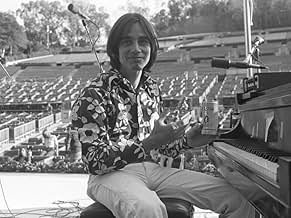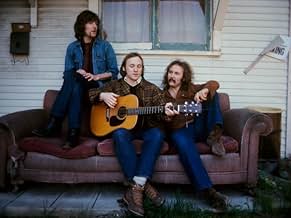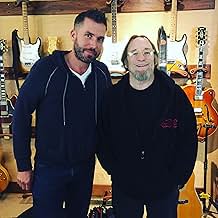AVALIAÇÃO DA IMDb
8,2/10
1,4 mil
SUA AVALIAÇÃO
Adicionar um enredo no seu idiomaDocumentary pulls back the curtain on a mythical world and provides an up-close look at the lives of the musicians who inhabited Laurel Canyon. It paints an intimate portrait of the artists ... Ler tudoDocumentary pulls back the curtain on a mythical world and provides an up-close look at the lives of the musicians who inhabited Laurel Canyon. It paints an intimate portrait of the artists who created a music revolution that would change popular culture.Documentary pulls back the curtain on a mythical world and provides an up-close look at the lives of the musicians who inhabited Laurel Canyon. It paints an intimate portrait of the artists who created a music revolution that would change popular culture.
- Indicado para 3 Primetime Emmys
- 2 vitórias e 7 indicações no total
Explorar episódios
Avaliações em destaque
In the years this documentary covers, I went from 15 to 25. I listened to these songs on the radio, bought the albums, and went to the concerts. It was a time of explosive creativity in pop music of all kinds, from England to Motown to Nashville to San Francisco and L. A., and Laurel Canyon was the epicenter of everything happening in L. A. As the documentary shows, the singer/songwriters and bands all found their way to a close knit community, where they fed each other's creative juices, and made a lot of memorable music. Clearly it was quite a project, as there are interviews from many years past with artists long dead. It was great to see one of my favorite bands, Love, get a fair amount of attention, but I don't see how the band Spirit got no mention at all. They did some of the most creative music of the time, and their guitarist, Randy California, invented various devices that are now incorporated into every electric guitar made. The band's chief composer, Jay Ferguson, is still doing tv and movie scores today.
Highly recommended, especially for those of you unaware of what went on in that place at that time.
10dvh27
Amazing doc, loved the way it flowed, loved the way the narration was done with audio as opposed to having someone In the interview chair which definitely made it more romantic in my opinion. Yes a lot we have heard before but we have never heard it before in such a wonderfully mystical way. Loved it.
"It was just about a time, the creative awakening." ~ Jackson Browne
Allison Ellwood directed this two-part docuseries that covers the time and place where many of the top musicians of the day lived and hung out in a magical, semi-communal style life in the hills of California's Laurel Canyon in the heyday of the 1960s and early 1970s. As a child, I was transplanted from the midwest to the base of this fertile canyon and into this creative aura that permeated my soul.
The film moves fast, but not too fast, in a sumptuous display of picture and video images that tumble forward in accompaniment to the tunes and tales of beloved Troubadours.
Photographers Henry Diltz and Nurit Wilde, whose photographic contributions are seminal to documenting this tremendous time, both explain how they began taking pictures of the talented, photogenic folks on the cutting edge of the music and social scene to capture the moments they were part of. Over time, their photographic passions unfolded into stunning historical archives of this special time in the canyon and the reach these musicans had on the world.
This pleasureful project wove together individual stories I'd heard over the years with bits and bobs that were new to me. No matter how much you already know or not, this film offers a satisfying overview of the scene: David Crosby produced Joni Mitchell's first album in Florida and brought her to California where they landed in the rural canyon that runs as an artery through urban Los Angeles. Many of the artists-in-residence were hosted by, (and introduced to each other via), the exquisite, magnanimous "Mama" Cass Elliot of The Mamas & The Papas.
Crosby, Still, and Nash, and ultimately Young, hook up and go through various ups-and-down stages of their musical partnership. Linda Ronstadt and JD Souther have a cute meet and move in together, leading to love and creative collaboration; those in the orbit of luminous song stylist extraordinare, Linda, found themselves incarnating as a supergroup, The Eagles.
Graham Nash narrates his sweet story of how he and Joni Mitchell, then deep in domestic bliss, ate at Art's Deli on Ventura Blvd. one morning, after which Joni bought a vase she fancied, they returned to their canyon home, Joni went home to pick flowers to fill her new pretty purchase, and while she was out, her piano was empty and Graham presided over it and out spilled "Our House."
There is precious video of Eric Clapton listening gape mouthed to a fresh Joni play her unique guitar chords at a house party; Nurit Wilde adored taking photos of the affable Peter Tork, who had a penchant for nudity, and hosted pool parties at his haven in the hills; and one of my favorite moments is when Jackson Browne, the new kid, (then a georgous, cherub-faced young man), played "Song for Adam," for an impressed David Crosby, who dubbed Jackson part of the new wave of canyon musicians.
Apolitical young singer-songwriters found their voice during this transformative time. A seminal moment occured for Stephen Stills in 1966 when he witnessed the Sunset Strip curfew riots with violent clashes between police and the youth; he went home and wrote, "For What It's Worth."
In 1969, the moon landing was followed and juxtiposed by the Manson Murders; one positively electrifying event so far away, yet glowed larger than life in every living room in the country, and the other, awful events, so close by and negatively charged that they cast a gorey gloom over the graceful goodness of the days.
Groups and singers that brought country music into the rock fold were covered, as was The Monterey Pop Festival, and the move from playng intimate clubs like the Troubadour (where the artists could meet up, collaborate, and soak in each other's songs) to being booked at huge arenas, where larger audiences could enjoy the shows, but the cozy creativity of the Laurel Canyonites was lost.
The list of talent in the canyon included: Joni Mitchell; Crosby, Still, Nash & Young; Buffalo Springfield; The Byrds; The Mamas & The Papas; The Doors; Alice Cooper;The Monkees; Love; The Turtles; Jackson Browne; Linda Ronstadt; Little Feat; and The Flying Burrito Brothers. Steve Martin too!
I highly recommend this movie.
Allison Ellwood directed this two-part docuseries that covers the time and place where many of the top musicians of the day lived and hung out in a magical, semi-communal style life in the hills of California's Laurel Canyon in the heyday of the 1960s and early 1970s. As a child, I was transplanted from the midwest to the base of this fertile canyon and into this creative aura that permeated my soul.
The film moves fast, but not too fast, in a sumptuous display of picture and video images that tumble forward in accompaniment to the tunes and tales of beloved Troubadours.
Photographers Henry Diltz and Nurit Wilde, whose photographic contributions are seminal to documenting this tremendous time, both explain how they began taking pictures of the talented, photogenic folks on the cutting edge of the music and social scene to capture the moments they were part of. Over time, their photographic passions unfolded into stunning historical archives of this special time in the canyon and the reach these musicans had on the world.
This pleasureful project wove together individual stories I'd heard over the years with bits and bobs that were new to me. No matter how much you already know or not, this film offers a satisfying overview of the scene: David Crosby produced Joni Mitchell's first album in Florida and brought her to California where they landed in the rural canyon that runs as an artery through urban Los Angeles. Many of the artists-in-residence were hosted by, (and introduced to each other via), the exquisite, magnanimous "Mama" Cass Elliot of The Mamas & The Papas.
Crosby, Still, and Nash, and ultimately Young, hook up and go through various ups-and-down stages of their musical partnership. Linda Ronstadt and JD Souther have a cute meet and move in together, leading to love and creative collaboration; those in the orbit of luminous song stylist extraordinare, Linda, found themselves incarnating as a supergroup, The Eagles.
Graham Nash narrates his sweet story of how he and Joni Mitchell, then deep in domestic bliss, ate at Art's Deli on Ventura Blvd. one morning, after which Joni bought a vase she fancied, they returned to their canyon home, Joni went home to pick flowers to fill her new pretty purchase, and while she was out, her piano was empty and Graham presided over it and out spilled "Our House."
There is precious video of Eric Clapton listening gape mouthed to a fresh Joni play her unique guitar chords at a house party; Nurit Wilde adored taking photos of the affable Peter Tork, who had a penchant for nudity, and hosted pool parties at his haven in the hills; and one of my favorite moments is when Jackson Browne, the new kid, (then a georgous, cherub-faced young man), played "Song for Adam," for an impressed David Crosby, who dubbed Jackson part of the new wave of canyon musicians.
Apolitical young singer-songwriters found their voice during this transformative time. A seminal moment occured for Stephen Stills in 1966 when he witnessed the Sunset Strip curfew riots with violent clashes between police and the youth; he went home and wrote, "For What It's Worth."
In 1969, the moon landing was followed and juxtiposed by the Manson Murders; one positively electrifying event so far away, yet glowed larger than life in every living room in the country, and the other, awful events, so close by and negatively charged that they cast a gorey gloom over the graceful goodness of the days.
Groups and singers that brought country music into the rock fold were covered, as was The Monterey Pop Festival, and the move from playng intimate clubs like the Troubadour (where the artists could meet up, collaborate, and soak in each other's songs) to being booked at huge arenas, where larger audiences could enjoy the shows, but the cozy creativity of the Laurel Canyonites was lost.
The list of talent in the canyon included: Joni Mitchell; Crosby, Still, Nash & Young; Buffalo Springfield; The Byrds; The Mamas & The Papas; The Doors; Alice Cooper;The Monkees; Love; The Turtles; Jackson Browne; Linda Ronstadt; Little Feat; and The Flying Burrito Brothers. Steve Martin too!
I highly recommend this movie.
With a majority of today's pop\rock music either created inside a game show, or lost in streaming obscurity Laural Canyon shines a light on what could be possible again. Obviously the record business is not the same, and the modality of sharing new music has radically changed. However, LC teaches us the music that changed us came from a group of people who were first and foremost community minded. The concept of a ' music scene' cannot be lost on the viewer. What that music offers the listener, the enthusiast is an energy. It seems to me it's difficult if not impossible for a lasting music scene filled with energy and life to exist inside one's and zero's alone. If you love music and want to share how it was created out of thin air (and how it could happen again), show this to your teenager. Before it fades away into the dust of 'old stuff'.
This three hour epix Documentary does a pretty solid job of covering the story of the famed Hollywood Hills enclave's music scene from the mid-60s to the mid-70s. The California Sound as it later became known as.
In this Doc's telling the beginnings of the Laurel Canyon scene flowed through The Byrds and The Buffalo Springfield into the super-group Crosby, Stills, Nash & Young. The tribal leader seemed to be David Crosby, who not only was a member of all three bands, but, also helped nurture singer-songwriters like Joni Mitchell and Jackson Browne (the sad irony being, as Crosby says in the Doc about him, REMEMBER MY NAME, is that none of the artists he ever played with will even speak to him now). As the scene grew, so did the number of musicians who drifted through including The Doors, Love and The Eagles.
Still photographers Henry Diltz and Nurit Wilde are here to share their vast vaults of pictures they snapped along with the stories that went with them. Director Alison Ellwood and her team also cobbled together a good array of film clips to illustrate, along with healthy doses of the actual music (licensing rights permitting, I assume). I'll leave it to those with a more encyclopedic knowledge to argue over which artists got enough/not enough coverage here or over which bands and singers were overlooked. My only quibble is that Ellwood occasionally lets her interviewees dictate where her focus goes. It's not important to archive each and every band member's comings and goings, and others who never even lived in the Canyon seem to have just attended a party or two. It's all interesting stuff, but, unless you are doing a Ken Burns style 15 hour series, the focus should have stayed on the scene proper. Still, overall, LAUREL CANYON is quite good (and a heck of an improvement over last year's cliquish ECHO IN THE CANYON).
In this Doc's telling the beginnings of the Laurel Canyon scene flowed through The Byrds and The Buffalo Springfield into the super-group Crosby, Stills, Nash & Young. The tribal leader seemed to be David Crosby, who not only was a member of all three bands, but, also helped nurture singer-songwriters like Joni Mitchell and Jackson Browne (the sad irony being, as Crosby says in the Doc about him, REMEMBER MY NAME, is that none of the artists he ever played with will even speak to him now). As the scene grew, so did the number of musicians who drifted through including The Doors, Love and The Eagles.
Still photographers Henry Diltz and Nurit Wilde are here to share their vast vaults of pictures they snapped along with the stories that went with them. Director Alison Ellwood and her team also cobbled together a good array of film clips to illustrate, along with healthy doses of the actual music (licensing rights permitting, I assume). I'll leave it to those with a more encyclopedic knowledge to argue over which artists got enough/not enough coverage here or over which bands and singers were overlooked. My only quibble is that Ellwood occasionally lets her interviewees dictate where her focus goes. It's not important to archive each and every band member's comings and goings, and others who never even lived in the Canyon seem to have just attended a party or two. It's all interesting stuff, but, unless you are doing a Ken Burns style 15 hour series, the focus should have stayed on the scene proper. Still, overall, LAUREL CANYON is quite good (and a heck of an improvement over last year's cliquish ECHO IN THE CANYON).
Você sabia?
- ConexõesFeatured in The 2020 Primetime Creative Arts Emmy Awards (2020)
Principais escolhas
Faça login para avaliar e ver a lista de recomendações personalizadas
Detalhes
- Data de lançamento
- País de origem
- Central de atendimento oficial
- Idioma
- Também conhecido como
- Laurel Canyon: A Place in Time
- Locações de filme
- Empresas de produção
- Consulte mais créditos da empresa na IMDbPro
- Tempo de duração1 hora 18 minutos
- Cor
- Mixagem de som
- Proporção
- 1.78 : 1
Contribua para esta página
Sugerir uma alteração ou adicionar conteúdo ausente

Principal brecha
By what name was Laurel Canyon (2020) officially released in India in English?
Responda

































